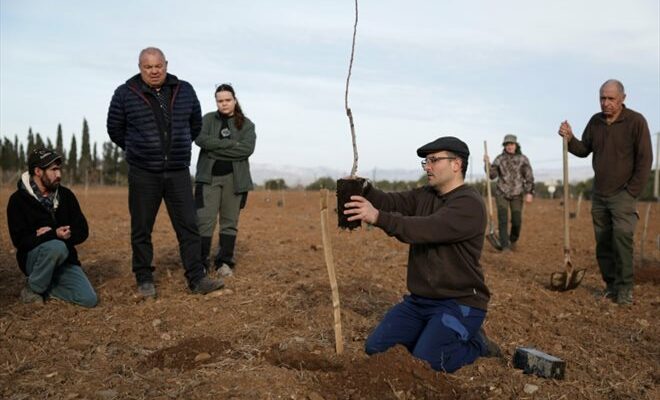A man plants a pistachio tree in a field in Claira, in the Pyrénées-Orientales, on February 8, 2024 (AFP/Archives/Valentine CHAPUIS)
The sun has not yet fully risen when they are already there, at the edge of a freshly plowed field in Claira, a small town in the Pyrénées-Orientales. Around thirty volunteers, ready to plant pistachio trees that bring hope in the face of the drought that has plagued this department since 2021.
In these arid conditions, these shrubs – currently puny bare trunks of around sixty centimeters – stand out for their low water requirements and their ability to grow almost everywhere, including in the stony and dried out wastelands of the Roussillon plain.
It is at the initiative of the association Avenir Mediterranean Resilient Agricultural Productions (Aparm) that we are preparing, on this February morning, to plant around 80 pistachio trees of four different varieties, around fifteen kilometers from Perpignan .

Planting pistachio trees in a field in Claira, in the Pyrénées-Orientales, February 8, 2024 (AFP/Valentine CHAPUIS)
After coffee and breakfast, one of the association’s vice-presidents, Pierre Pineiro, squats near the pots and explains to the volunteers how to plant the pistachio trees.
These are grafts: here, the pistachios sold in France do not grow in nature. But the terebinth pistachio tree, whose fruits are tiny, abounds in the scrubland and was chosen as the rootstock for the four varieties chosen, from Greece and Italy. It will then be necessary to identify the ones best suited to the Pyrénées-Orientales.
– Indicators in the red –
With pistachio, Aparm seeks to respond to three challenges, explains Myriam Levalois, coordinator of the association: identify plants adapted to lack of water; diversify crops to provide additional income for farmers; and reinvest wastelands, which are very vulnerable to fires.

Volunteers plant pistachio trees in a field in Claira, in the Pyrénées-Orientales, on February 8, 2024 (AFP/Archives/Valentine CHAPUIS)
Problems that are becoming pressing in the Pyrénées-Orientales, where “all the indicators are generally red”, explains Simon Mittelberger, climatologist at Météo France, to AFP.
In mid-February, the desperately dry soils display a humidity level that is usually measured at the end of August, with little hope of improvement because the precipitation over the next two weeks should once again be “clearly insufficient”, he says. he.
In addition, the water tables are at their lowest and “the snow cover (of the Pyrenees) is very, very weak, not to say almost non-existent, whereas normally, it is this snow which makes it possible to store water for restore it in the spring and feed a whole bunch of rivers and lakes”, also underlines Mr. Mittelberger.

Two hunters participate in planting pistachio trees in a field in Claira, in the Pyrénées-Orientales, on February 8, 2024 (AFP/Archives/Valentine CHAPUIS)
This morning, the pistachio planters only saw tiny white streams at the top of Canigou, the region’s emblematic peak. Everywhere else, the landscape displays an ocher shades punctuated with the dark green spots of Mediterranean pines.
You will have to wait for the pistachio trees to add their colors to this palette, because the first flowering generally only occurs after four years and the first harvest another three years later.
– For the future –
“We plant for future generations,” breathes Marguerite Bonzoms. This 59-year-old farmer based not far away, in Calce, decided with the support of Aparm to plant 50 acres of pistachio trees in January on her Bon Estir estate, a mainly wine-producing 6.5 hectare farm.

A man waters a newly planted pistachio tree in Claira, in the Pyrénées-Orientales, on February 8, 2024 (AFP/Archives/Valentine CHAPUIS)
“We are the first to plant, it’s true that we take risks,” she admits in a soft voice. But faced with the lack of water, which cost 70% of its wine harvest in 2023, we must “turn towards more sustainable crops, (…) more adapted to what awaits us in 2050”.
A shift already made in 2015 in the neighboring department of Aude by Laurent and Bruno Gianesini, two brothers at the head of a 400 hectare farm in Villarzel-du-Razès, mainly cereals and vines, but which now includes 6 hectares pistachio trees.
Among the latter, planted over the years, the oldest are already bearing fruit: 100 kilos per hectare in 2023, and the harvest could double or triple this year. At their maturity, reached around 25 years, these trees can deliver up to 1 to 1.5 tonnes of pistachios.

The vice-president of the Avenir Mediterranean Resilient Agricultural Productions (Aparm) association, Pierre-Antoine Pineiro (c), shows how to plant a pistachio tree, on February 8, 2024 in Claira, in the Pyrénées-Orientales (AFP/Archives/Valentine CHAPUIS )
“I think the turn we took is the right one. And fortunately we took it,” confides Laurent Gianesini, 42 years old. After the heatwaves of 2003 and 2006, followed by two sweltering summers in 2010 and 2011, he and his brother understood that things were changing for good. Of which act.
As a result, his pistachio trees held up “very well this year, without a single drop of water”.
This is good, because this is the quantity of water that the Pyrénées-Orientales received.
© 2024 AFP
Did you like this article ? Share it with your friends using the buttons below.




